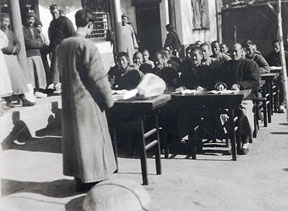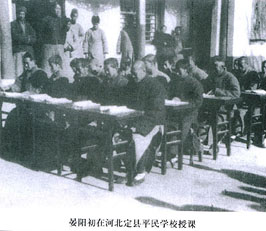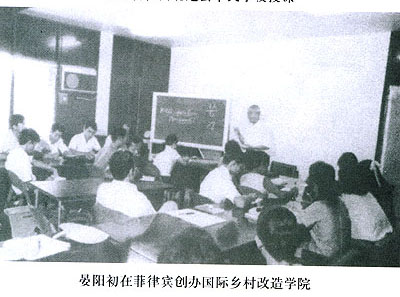 |
|

Outdoor classroom in Dingxian, 1931 |
Popular Education Movement
When Yan returned to China in 1920, he successfully lobbied to become head of the Department of Popular Education, a new autonomous department in Beijing.
In 1922, he organized to set up more than 200 schools for popular education in Changsha, capital of Hunan Province. He reduced the Chinese vocabulary of forty thousand characters to the 1,300 most common characters and published four readers, which cost twelve cents total. With this handbook, Yan started the four month-span education with the purpose of getting rid of illiteracy. There were more than 50,000 beneficiary students. Mao Zedong was one of the voluntary teachers at that time.
|
In 1923, Yan continued this activity in Beijing, Huabei, Huazhong, Huaxi, Huanan and etc.in Mar 26, the National Association of the Mass Education Movement (MEM) was formally organized. In 1926, Yan and the intellects who had the same interest, went to Zhaicheng Village to promote their rural education program. In 1929, the center of MEM was transferred to Dingxian. It addressed four interlocking problems of village life: poverty, disease, ignorance and misgovernment.
The pilot project began in Zhaichengcun, and all the activities were of most concern to local farmers.
In those years, Yan made great contribution in building popular education schools, setting up credit cooperatives, editing popular magazines, training doctors, building clinics, giving students medical aids and etc. |

Yan was teaching. |

Ten principles of rural revolution |
At the beginning of 1930, the popular education trial was confirmed by the vice head of Ministry of Civil Affairs and then it was promoted in the national wide. In each province, one county was selected as the popular education trial. The most famous ones were Dingxian, Hengshan, Xindu and Huaxi. In 1940, with the help of Zhang Zhi-zhong and Lu Zuo-fu, Yan set up Rural Reconstruction College. In 1945, it was renamed Private China Rural Reconstruction College, which had four majors, including education, agriculture, water conservancy and society. Famous scholars, such as Sun Fu-guo, Hu Yan-qing and Xiong Fo-xi were invited to be teachers there.
In 1945 after the Anti-Japan War, Yan ever |
tried to ask Jiang Jie-shi to invest more into education, but it was refused. Then, Yan continued to persuade American congress and the president Mr. Truman. Finally, the "Jimmy Yen provision" was ten percent of the U.S. 1948 aid package to China. In 1949, the Chinese Communist Party(CCP) finally succeeded in civil war. As Yan was Christian, he was not welcomed by CCP and he went to Taiwan. Since then, Yan and his popular education movement were disappeared in Chinese mainland.
|
|
Popular education in the world
Soon after Yan left Chinese mainland, he went to Taiwan and America, where he assisted to promote popular education in developing countries in South America, Africa and Southeastern Asia. In 1956, Yan set up International Rural Construction College in Philippine. Until now, this college endeavored to promote popular education and train teachers in the third world. |
 |
|
|
|
 |
|